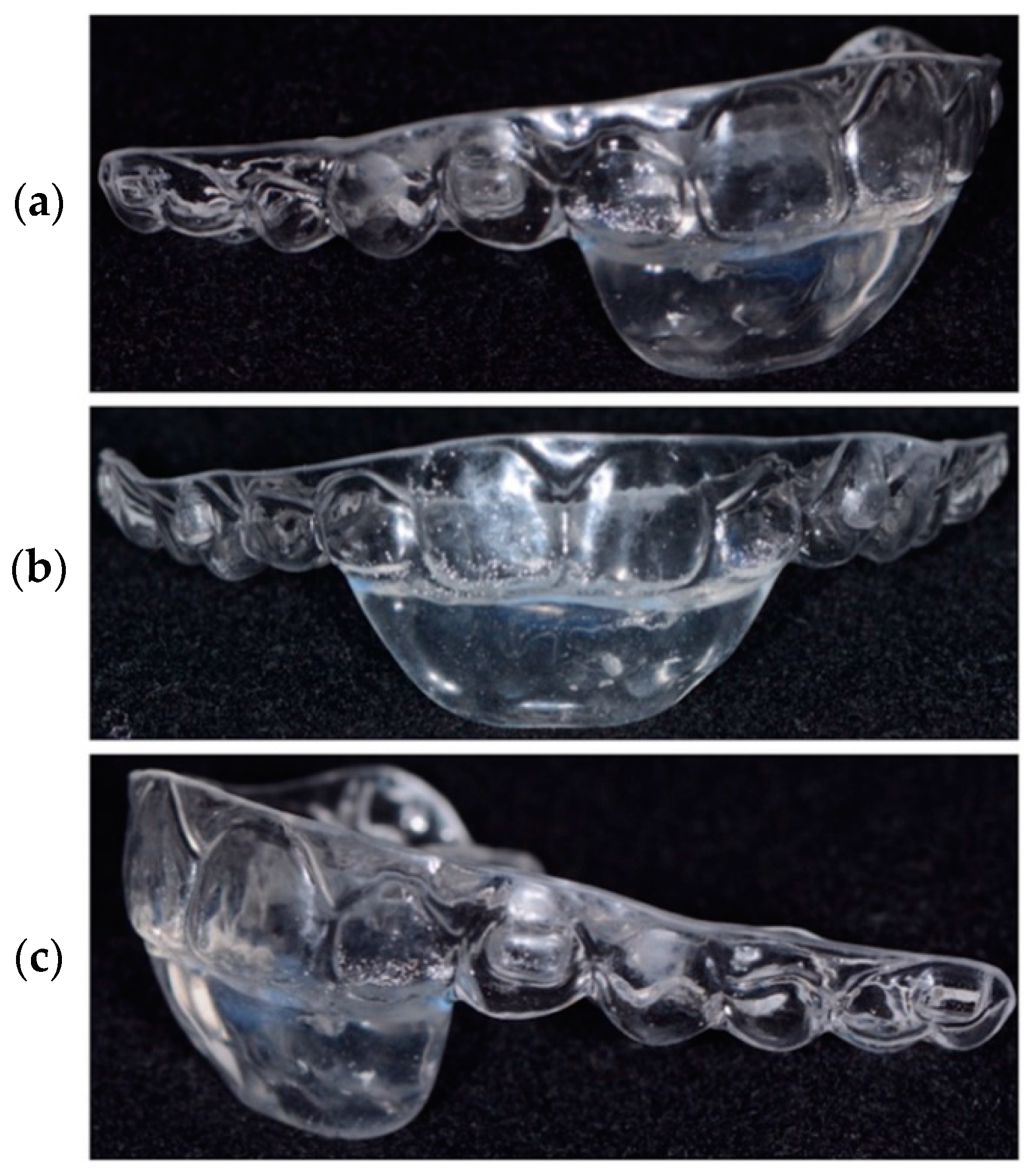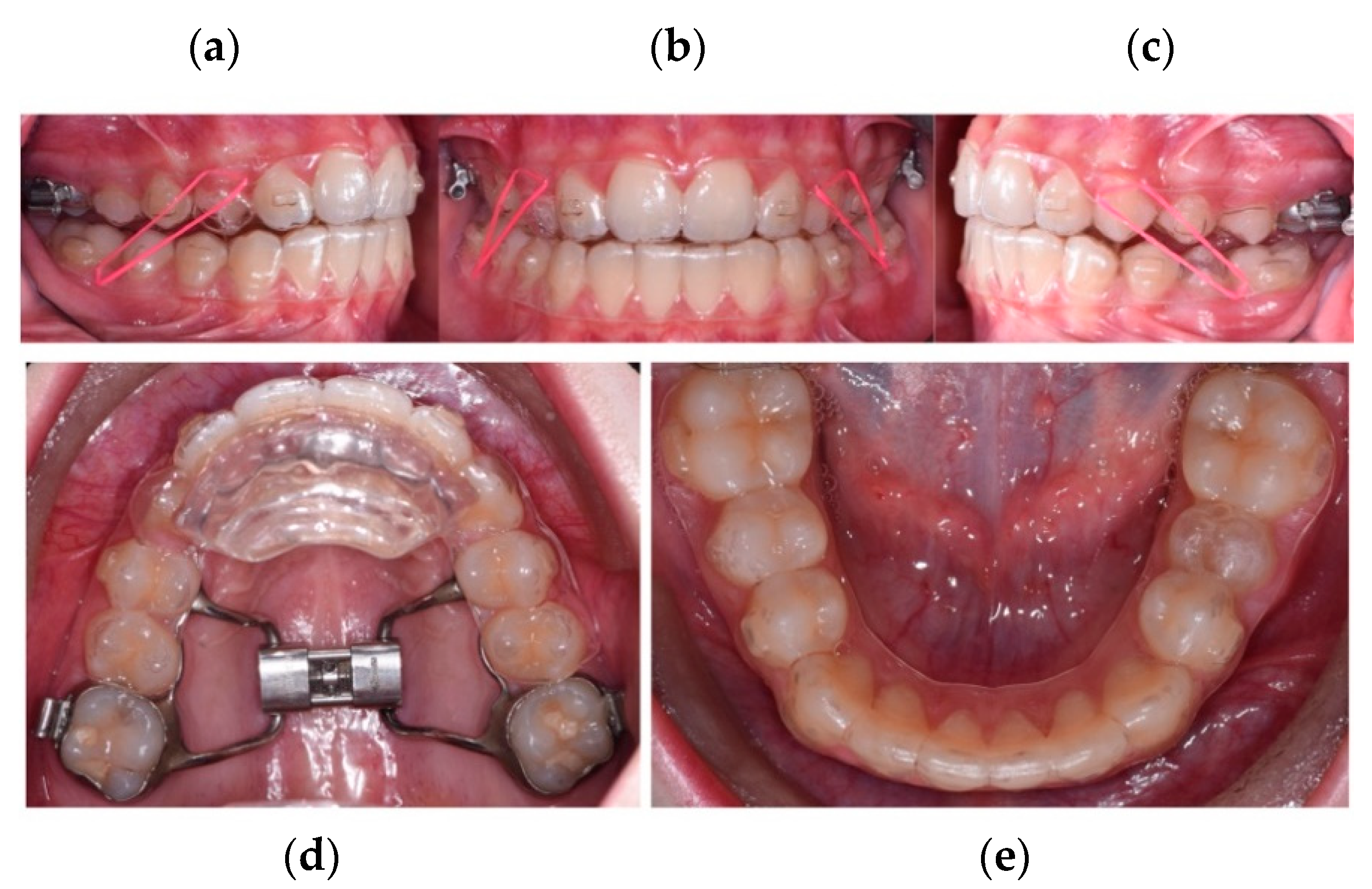Class II Treatment in Growing Patients: Preliminary Evaluation of the Skeletal and Dental Effects of a New Clear Functional Appliance
Abstract
:1. Introduction
2. Materials and Methods
3. Statistical Analysis
4. Results
5. Discussion
6. Conclusions
Author Contributions
Funding
Institutional Review Board Statement
Informed Consent Statement
Conflicts of Interest
References
- McNamara, J.A., Jr. Components of Class II malocclusion in children 8–10 years of age. Angle Orthod. 1981, 51, 177–202. [Google Scholar] [PubMed]
- Tollaro, I.; Baccetti, T.; Franchi, L.; Tanasescu, C.D. Role of posterior transverse interarch discrepancy in Class II, Division 1 malocclusion during the mixed dentition phase. Am. J. Orthod. Dentofac. Orhop. 1996, 110, 417–422. [Google Scholar] [CrossRef]
- Frankel, R.; Frankel, C. Orthodontics in orofacial region with help of function regulators. Inf. Orthod. Kieferorthop. 1988, 20, 277–309. [Google Scholar]
- Perinetti, G.; Primožič, J.; Franchi, L.; Contardo, L. Treatment effects of removable functional appliances in prepubertal and pubertal Class II patients: A systematic review and meta-analysis of controlled studies. PLoS ONE 2015, 10, e0141198. [Google Scholar] [CrossRef]
- Baysal, A.; Uysal, T. Soft tissue effects of Twin Block and Herbst appliances in patients with Class II division 1 mandibular retrognathy. Eur. J. Orthod. 2013, 35, 71–81. [Google Scholar] [CrossRef] [Green Version]
- Gill, D.; Sharma, A.; Naini, F.; Jones, S. The Twin Block appliance for the correction of Class II malocclusion. Dent. Update 2005, 32, 158–168. [Google Scholar] [CrossRef]
- Walton, D.K.; Fields, H.W.; Johnston, W.M.; Rosenstiel, S.F.; Firestone, A.R.; Christensen, J.C. Orthodontic appliance preferences of children and adolescents. Am. J. Orthod. Dentofac. Orthop. 2010, 138, 698.e1–698.e12. [Google Scholar] [CrossRef]
- Lombardo, L.; Arreghini, A.; Ramina, F.; Huanca Ghislanzoni, L.T.; Siciliani, G. Predictability of orthodontic movement with orthodontic aligners: A retrospective study. Prog. Orthod. 2017, 18, 35. [Google Scholar] [CrossRef] [Green Version]
- Rossini, G.; Parrini, S.; Castroflorio, T.; Deregibus, A.; Debernardi, C.L. Efficacy of clear aligners in controlling orthodontic tooth movement: A systematic review. Angle Orthod. 2014, 85, 881–889. [Google Scholar] [CrossRef] [Green Version]
- Baccetti, T.; Franchi, L.; McNamara, J.A., Jr. The cervical vertebral maturation (CVM) method for the assessment of optimal treatment timing in dentofacial orthopedics. Semin. Orthod. 2005, 11, 119. [Google Scholar] [CrossRef]
- O’Brien, K.; Wright, J.; Conboy, F.; Sanjie, Y.; Mandall, N.; Chadwick, S.; Connolly, I.; Cook, P.; Birnie, D.; Hammond, M.; et al. Effectiveness of early orthodontic treatment with the Twin-Block appliance: A multicenter, randomized, controlled trial. Part 1: Dental and skeletal effects. Am. J. Orthod. Dentofac. Orthop. 2003, 124, 234–243. [Google Scholar] [CrossRef]
- Illing, H.M.; Morris, D.O.; Lee, R.T. A prospective evaluation of Bass, Bionator and Twin block appliances. Part I—The hard tissues. Eur. J. Orthod. 1998, 20, 501–516. [Google Scholar] [CrossRef] [PubMed]
- Khojia, A.; Fida, M.; Shaikh, A. Cephalometric evaluation of the effects of Twin Block appliance in subjects with Class II, Division I malocclusion among different cervical vertebral maturation stages. Dent. Press J. Orthod. 2016, 21, 73–84. [Google Scholar] [CrossRef] [Green Version]
- Guinot, F.; Ferrer, M.; Diaz-Gonzalez, L.; Garcia, C.; Maura, I. Effects of Orthodontic Functional Appliances in Relation to Skeletal Maturation of Cervical Vertebrae in Class II Malocclusion. J. Clin. Pediatr. Dent. 2021, 145, 352–358. [Google Scholar] [CrossRef] [PubMed]
- Di Fazio, D.; Lombardo, L.; Gracco, A.; D’Amico, P.; Siciliani, G. Lip Pressure at rest and during function in 2 groups of patients with different occlusions. Am. J. Orthod. Dentofac. Orthop. 2011, 139, e1–e6. [Google Scholar] [CrossRef] [PubMed]
- Caruso, S.; Nota, A.; Caruso, S.; Severino, M.; Gatto, R.; Meuli, S.; Mattei, A.; Tecco, S. Mandibular advancement with clear aligners in the treatment of skeletal class II. A retrospective controlled study. Eur. J. Paediatr. Dent. 2021, 22, 26–30. [Google Scholar]
- Cozza, P.; Baccetti, T.; Franchi, L.; De Toffol, L.; McNamara, J.A., Jr. Mandibular canges produced by functional appliances in Class II malocclusion: A systematic review. Am. J. Orthod. Dentofac. Orthop. 2006, 129, 599.e1–599.e12. [Google Scholar] [CrossRef] [Green Version]
- Scribante, A.; Gallo, S.; Celmare, R.L.; D’Antò, V.; Grippaudo, C.; Gandini, P.; Sfondrini, M.F. Orthodontic debonding and tooth sensitivity of anterior and posterior teeth. A Prospective clinical trial. Angle Orthod. 2020, 90, 766–773. [Google Scholar] [CrossRef]
- Modesti-Vedolin, G.; Chies, C.; Chaves-Fagondes, S.; Piza-Pelizzer, E.; Lima-Grossi, M. Efficacy of a mandibular advancement intraoral appliance (MOA) for the treatment of obstructive sleep apnea syndrome (OSAS) in pediatric patients: A pilot-study. Med. Oral Patol. Oral Cir. Bucal. 2018, 23, e656–e663. [Google Scholar] [CrossRef]
- Neagos, A.; Vrinceanu, D.; Dumitru, M.; Costache, A.; Cergan, R. Demographic, anthropometric, and metabolic characteristics of obstructive sleep apnea patients from Romania before the COVID-19 pandemic. Exp. Ther. Med. 2021, 22, 1487. [Google Scholar] [CrossRef]
- ToTh, L.R.; McNamara, J.A., Jr. Treatment effects produced by the twin block appliance and the FR-2 appliance of Frankel compared with an untreated Class II sample. Am. J. Orthod. Dentofac. Orthop. 1999, 116, 597–609. [Google Scholar] [CrossRef]
- Stahl, F.; Baccetti, T.; Franchi, L.; McNamara, J.A., Jr. Longitudinal growth changes in untreated subjects with Class II Division 1 malocclusion. Am. J. Orthod. Dentofac. Orthop. 2008, 134, 125–137. [Google Scholar] [CrossRef] [PubMed]
- Baccetti, T.; Stahl, F.; McNamara, J.A., Jr. Dentofacial growth changes in subjects with untreated Class II malocclusion from late puberty through young adulthood. Am. J. Orthod. Dentofac. Orthop. 2009, 135, 148–154. [Google Scholar] [CrossRef] [PubMed]
- Moro, A.; Mattos, C.; Borges, S.; Flores-Mir, C.; Topolski, F. Stability of class II corrections with removable and fixed functional appliances: A literature review. J. World Fed. Orthod. 2020, 9, 56–67. [Google Scholar] [CrossRef] [PubMed]












| Angular Cephalometric Values (Degrees) | |||||
|---|---|---|---|---|---|
| SNA | SNB | ANB | FMA | MP-SN | U1-Occl plane |
| L1-cc plane | IMPA | U1-PP | PP-GoGn | SN-PP | SN-GoGn |
| Linear Cephalometric Values (mm) | ||
|---|---|---|
| Wits | Mand Base Go-Pg | Mand Length: Co-Gn |
| Linear Measurements on Digital Models (mm) | |||
|---|---|---|---|
| Overjet | Overbite | Right molar class | Left molar class |
| Outcome | ICC Index |
|---|---|
| SNA | 0.969 |
| SNB | 0.975 |
| ANB | 0.952 |
| Wits | 0.974 |
| FMA | 0.986 |
| MP-SN | 0.984 |
| U1-Occl plane | 0.994 |
| U1-Palatal Plane | 0.947 |
| L1-Occl Plane | 0.941 |
| IMPA | 0.969 |
| SN-PP | 0.944 |
| PP-GoGn | 0.969 |
| Mand Base: Go-Pg | 0.974 |
| Mand Length: Co-Gn | 0.999 |
| OVJ | 0.987 |
| OVB | 0.961 |
| Right molar class | 0.998 |
| Left molar class | 0.998 |
| Variable | Num | T0 (Pre Treatment) | T1 (Post Treatment) | Δ Mean Differences | p Value |
|---|---|---|---|---|---|
| SNA | 45 | 79.50 ± 3.376 | 79.84 ± 3.483 | −0.34 | 0.1 |
| SNB | 45 | 74.17 ± 2.913 | 75.71 ± 2.871 | +1.538 | 0.00002 * |
| ANB | 45 | 5.349 ± 1.221 | 4.124 ± 1.299 | +1.224 | 0.00002 * |
| Wits | 45 | 3.231 ± 2.068 | 0.442 ± 1.540 | −2.789 | 0.00003 * |
| FMA | 45 | 22.7 ± 5.104 | 23.8 ± 3.841 | +1.102 | 0.2 |
| MP_SN | 45 | 32.63 ± 4.327 | 33.49 ± 4.303 | +0.8622 | 0.04 |
| U1_Occl plane | 45 | 58.55 ± 8.459 | 59.62 ± 6.344 | +1.076 | 0.5 |
| U1_Palatal Plane | 45 | 111.8 ± 9.914 | 111.0 ± 15.216 | −0.7267 | 0.7 |
| L1_Occl Plane | 45 | 67.86 ± 4.251 | 66.96 ± 4.375 | −0.9089 | 0.4 |
| IMPA | 45 | 97.7 ± 5.493 | 99.0 ± 4.545 | +1.3 | 0.00003 * |
| SN_PP | 45 | 8.198 ± 2.954 | 8.540 ± 2.727 | +0.3422 | 0.5 |
| PP_GoGn | 45 | 20.75 ± 5.162 | 21.77 ± 4.523 | +1.018 | 0.1 |
| Go_Pg | 45 | 59.01 ± 3.752 | 62.44 ± 4.343 | +3.422 | 0.00003 * |
| Co_Gn | 45 | 94.80 ± 5.586 | 97.82 ± 5.811 | +3.016 | 0.00001 * |
| Overjet (OJ) | 45 | 5.409 ± 2.194 | 3.089 ± 0.922 | −2.32 | 0.0001 * |
| Overbite (OB) | 45 | 3.600 ± 1.480 | 2.282 ± 1.131 | −1.318 | 0.0004 * |
| Right molar class | 45 | 4.005 ± 1.303 | 1.460 ± 1.350 | −2.545 | 0.0000008 * |
| Left molar class | 45 | 3.871 ± 1.356 | 1.201 ± 1.357 | −2.67 | 0.0000001 * |
Publisher’s Note: MDPI stays neutral with regard to jurisdictional claims in published maps and institutional affiliations. |
© 2022 by the authors. Licensee MDPI, Basel, Switzerland. This article is an open access article distributed under the terms and conditions of the Creative Commons Attribution (CC BY) license (https://creativecommons.org/licenses/by/4.0/).
Share and Cite
Cremonini, F.; Cervinara, F.; Siciliani, G.; Lombardo, L. Class II Treatment in Growing Patients: Preliminary Evaluation of the Skeletal and Dental Effects of a New Clear Functional Appliance. Appl. Sci. 2022, 12, 5622. https://doi.org/10.3390/app12115622
Cremonini F, Cervinara F, Siciliani G, Lombardo L. Class II Treatment in Growing Patients: Preliminary Evaluation of the Skeletal and Dental Effects of a New Clear Functional Appliance. Applied Sciences. 2022; 12(11):5622. https://doi.org/10.3390/app12115622
Chicago/Turabian StyleCremonini, Francesca, Francesca Cervinara, Giuseppe Siciliani, and Luca Lombardo. 2022. "Class II Treatment in Growing Patients: Preliminary Evaluation of the Skeletal and Dental Effects of a New Clear Functional Appliance" Applied Sciences 12, no. 11: 5622. https://doi.org/10.3390/app12115622
APA StyleCremonini, F., Cervinara, F., Siciliani, G., & Lombardo, L. (2022). Class II Treatment in Growing Patients: Preliminary Evaluation of the Skeletal and Dental Effects of a New Clear Functional Appliance. Applied Sciences, 12(11), 5622. https://doi.org/10.3390/app12115622






